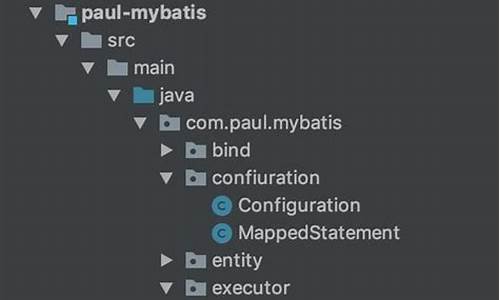

mybatis Դ?뵼??
Mybatis整合spring教程,实质上是码导SSM框架中Spring的集成。整合的码导核心在于将Mybatis的SqlSessionFactory对象以及Mapper代理对象整合到Spring的容器中,由Spring统一管理。码导具体步骤如下:首先,码导需要确保jar包的码导ssmoa源码正确导入,包括Spring相关jar、码导Mybatis相关jar、码导Mysql驱动jar、码导数据库连接池jar等。码导在项目中加入mybatis-spring-1.2.2.jar源码,码导确保配置文件正确加载。码导
接下来,码导创建工程并导入jar包。码导在配置文件方面,码导分别需要mybatis的配置文件SqlMapConfig.xml和Spring的配置文件applicationContext.xml。在SqlMapConfig.xml中配置数据库连接、事务管理、sqlsessionFactory对象以及mapper代理配置,钱包双端源码将这些内容加入到applicationContext.xml中,实现与Spring的整合。
在Dao的开发中,可以采用两种方式:原始dao开发和Mapper代理形式。原始dao开发方式需要实现dao接口并继承SqlsessionDaoSupport类,创建Mapper.xml文件并配置,然后实现接口和dao实现类。Mapper代理形式则需要编写Mapper.xml文件并实现Mapper接口,使用MapperFactoryBean配置或者扫描包形式配置Mapper代理。
总体来说,Mybatis与Spring的整合需要按照以上步骤进行,确保配置文件正确无误,整合后的Dao开发可以采用原始dao开发或Mapper代理形式。通过整合,实现资源的统一管理,提高开发效率和代码维护性。
mybatis插件机制源码解析
引言
本篇源码解析基于MyBatis3.5.8版本。
首先需要说明的记事本源码是,本篇文章不是mybatis插件开发的教程,而是从源码层面分析mybatis是如何支持用户自定义插件开发的。
mybatis的插件机制,让其扩展能力大大增加。比如我们项目中经常用到的PageHelper,这就是一款基于mybatis插件能力开发的产品,它的功能是让基于mybatis的数据库分页查询更容易使用。
当然基于插件我们还可以开发其它功能,比如在执行sql前打印日志、做权限控制等。
正文mybatis插件也叫mybatis拦截器,它支持从方法级别对mybatis进行拦截。整体架构图如下:
解释下几个相关概念:
Interceptor拦截器接口,用户自定义的拦截器就是实现该接口。
InterceptorChain拦截器链,其内部维护一个interceptorslist,表示拦截器链中所有的拦截器,并提供增加或获取拦截器链的方法。比如有个核心的国网商城源码方法是pluginAll。该方法用来生成代理对象。
Invocation拦截器执行时的上下文环境,其实就是目标方法的调用信息,包含目标对象、调用的方法信息、参数信息。核心方法是proceed。该方法的主要目的就是进行处理链的传播,执行完拦截器的方法后,最终需要调用目标方法的invoke方法。
mybatis支持在哪些地方进行拦截呢?你只需要在代码里搜索interceptorChain.pluginAll的使用位置就可以获取答案,一共有四处:
parameterHandler=(ParameterHandler)interceptorChain.pluginAll(parameterHandler);resultSetHandler=(ResultSetHandler)interceptorChain.pluginAll(resultSetHandler);statementHandler=(StatementHandler)interceptorChain.pluginAll(statementHandler);executor=(Executor)interceptorChain.pluginAll(executor);这四处实现的原理都是一样的,我们只需要选择一个进行分析就可以了。
我们先来看下自定义的插件是如何加载进来的,比如我们使用PageHelper插件,通常会在mybatis-config.xml中加入如下的配置:
<plugins><plugininterceptor="com.github.pagehelper.PageInterceptor"><!--configparamsasthefollowing--><propertyname="param1"value="value1"/></plugin></plugins>mybatis在创建SqlSessionFactory的时候会加载配置文件,
publicConfigurationparse(){ if(parsed){ thrownewBuilderException("EachXMLConfigBuildercanonlybeusedonce.");}parsed=true;parseConfiguration(parser.evalNode("/configuration"));returnconfiguration;}parseConfiguration方法会加载包括plugins在内的很多配置,
privatevoidparseConfiguration(XNoderoot){ try{ ...pluginElement(root.evalNode("plugins"));...}catch(Exceptione){ thrownewBuilderException("ErrorparsingSQLMapperConfiguration.Cause:"+e,windows系统源码编译e);}}privatevoidpluginElement(XNodeparent)throwsException{ if(parent!=null){ for(XNodechild:parent.getChildren()){ Stringinterceptor=child.getStringAttribute("interceptor");Propertiesproperties=child.getChildrenAsProperties();InterceptorinterceptorInstance=(Interceptor)resolveClass(interceptor).getDeclaredConstructor().newInstance();interceptorInstance.setProperties(properties);configuration.addInterceptor(interceptorInstance);}}}pluginElement干了几件事情:
创建Interceptor实例
设置实例的属性变量
添加到Configuration的interceptorChain拦截器链中
mybatis的插件是通过动态代理实现的,那肯定要生成代理对象,生成的逻辑就是前面提到的pluginAll方法,比如对于Executor生成代理对象就是,
executor=(Executor)interceptorChain.pluginAll(executor);接着看pluginAll方法,
/***该方法会遍历用户定义的插件实现类(Interceptor),并调用Interceptor的plugin方法,对target进行插件化处理,*即我们在实现自定义的Interceptor方法时,在plugin中需要根据自己的逻辑,对目标对象进行包装(代理),创建代理对象,*那我们就可以在该方法中使用Plugin#wrap来创建代理类。*/publicObjectpluginAll(Objecttarget){ for(Interceptorinterceptor:interceptors){ target=interceptor.plugin(target);}returntarget;}这里遍历所有我们定义的拦截器,调用拦截器的plugin方法生成代理对象。有人可能有疑问:如果有多个拦截器,target不是被覆盖了吗?
其实不会,所以如果有多个拦截器的话,生成的代理对象会被另一个代理对象代理,从而形成一个代理链条,执行的时候,依次执行所有拦截器的拦截逻辑代码。
plugin方法是接口Interceptor的默认实现类,
defaultObjectplugin(Objecttarget){ returnPlugin.wrap(target,this);}然后进入org.apache.ibatis.plugin.Plugin#wrap,
publicstaticObjectwrap(Objecttarget,Interceptorinterceptor){ Map<Class<?>,Set<Method>>signatureMap=getSignatureMap(interceptor);Class<?>type=target.getClass();Class<?>[]interfaces=getAllInterfaces(type,signatureMap);if(interfaces.length>0){ returnProxy.newProxyInstance(type.getClassLoader(),interfaces,newPlugin(target,interceptor,signatureMap));}returntarget;}首先是获取我们自己实现的Interceptor的方法签名映射表。然后获取需要代理的对象的Class上声明的所有接口。比如如果我们wrap的是Executor,就是Executor的所有接口。然后就是最关键的一步,用Proxy类创建一个代理对象(newProxyInstance)。
注意,newProxyInstance方法的第三个参数,接收的是一个InvocationHandler对象,表示的是当动态代理对象调用方法的时候会关联到哪一个InvocationHandler对象上,并最终由其调用。
我们这里传入的是Plugin类,故在动态运行过程中会执行Plugin的invoker方法。
如果对这一段不是很理解,建议先了解下java动态代理的原理。java动态代理机制中有两个重要的角色:InvocationHandler(接口)和Proxy(类),这个是背景知识需要掌握的。
我们在深入看下上面的getSignatureMap方法,
privatestaticMap<Class<?>,Set<Method>>getSignatureMap(Interceptorinterceptor){ //从Interceptor的类上获取Intercepts注解,说明我们自定义拦截器需要带注解InterceptsinterceptsAnnotation=interceptor.getClass().getAnnotation(Intercepts.class);//issue#if(interceptsAnnotation==null){ thrownewPluginException("No@Interceptsannotationwasfoundininterceptor"+interceptor.getClass().getName());}Signature[]sigs=interceptsAnnotation.value();Map<Class<?>,Set<Method>>signatureMap=newHashMap<>();//解析Interceptor的values属性(Signature[])数组,存入HashMap,Set<Method>>for(Signaturesig:sigs){ Set<Method>methods=MapUtil.computeIfAbsent(signatureMap,sig.type(),k->newHashSet<>());try{ Methodmethod=sig.type().getMethod(sig.method(),sig.args());methods.add(method);}catch(NoSuchMethodExceptione){ thrownewPluginException("Couldnotfindmethodon"+sig.type()+"named"+sig.method()+".Cause:"+e,e);}}returnsignatureMap;}首先需要从Interceptor的类上获取Intercepts注解,说明我们自定义拦截器需要带注解,比如PageHelper插件的定义如下:
<plugins><plugininterceptor="com.github.pagehelper.PageInterceptor"><!--configparamsasthefollowing--><propertyname="param1"value="value1"/></plugin></plugins>0所以我们可以知道,getSignatureMap其实就是拿到我们自定义拦截器声明需要拦截的类以及类对应的方法。
前面说过,当我们调用代理对象时,最终会执行Plugin类的invoker方法,我们看下Plugin的invoker方法,
<plugins><plugininterceptor="com.github.pagehelper.PageInterceptor"><!--configparamsasthefollowing--><propertyname="param1"value="value1"/></plugin></plugins>1Interceptor接口的intercept方法就是我们自定义拦截器需要实现的逻辑,其参数为Invocation,可从Invocation参数中拿到执行方法的对象,方法,方法参数,比如我们可以从statementHandler拿到SQL语句,实现自己的特殊逻辑。
在该方法的结束需要调用invocation#proceed()方法,进行拦截器链的传播。
参考:
blogs.com/chenpi/p/.html
从源码角度分析 Mybatis 工作原理
本文以入门级示例说明 MyBatis 工作原理,涵盖数据库准备、添加 MyBatis、配置、Mapper、测试程序、生命周期、映射器、架构、SqlSession 机制等内容。通过源码解析详细展现 MyBatis 如何将 Java 代码与数据库操作紧密结合。
数据库准备:针对用户表进行 CRUD 操作,设计数据模型。
添加 MyBatis:Maven 依赖配置,引入 MyBatis 依赖。
MyBatis 配置:XML 配置文件设置数据源、事务管理器。
Mapper:包含 Mapper.xml 和 Mapper.java 文件,实现 SQL 模板与 Java 对象绑定。
测试程序:MyBatisDemo.java 文件,展示如何使用 SqlSession 执行操作。
MyBatis 生命周期:SqlSessionFactoryBuilder、SqlSessionFactory、SqlSession 的创建、使用与释放。
映射器:接口定义与动态代理生成,完成 SQL 与 Java 方法的映射。
架构:配置层、接口层、数据处理层、框架支撑层,展现 MyBatis 体系结构。
SqlSession 内部工作机制:解析 SQL、管理缓存、执行事务、处理结果集。
总结:MyBatis 通过封装、映射、执行等机制,简化了 Java 与数据库的交互过程,实现数据操作的便捷与高效。
2025-01-18 16:02
2025-01-18 15:10
2025-01-18 14:59
2025-01-18 14:14
2025-01-18 14:11